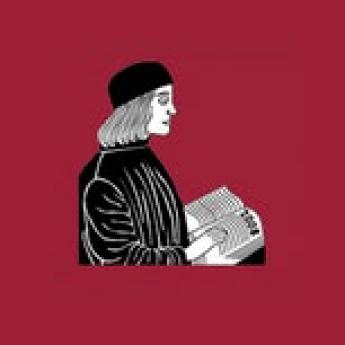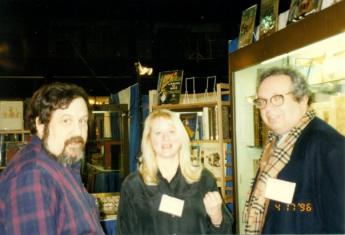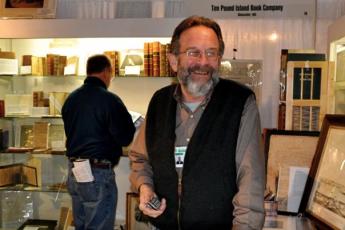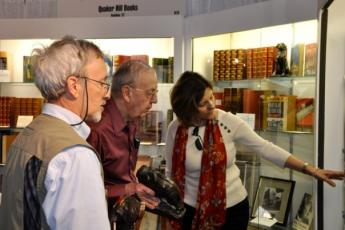2010 - 50th Anniversary

By Stuart Bennett
Book fairs have become such staple fodder for booksellers that it’s hard to imagine a time when they didn’t exist. But the “First Antiquarian Book Fair,” as it was called, took place in New York from April 4-9, 1960, fifty years almost to the day before our scheduled gala event at the Park Avenue Armory from April 8-11, 2010. Madeleine Stern reminisced about this first ABAA book fair in our newsletter – then called The Professional Rare Bookman – in 1982: It took place in a New York concert hall measuring 1,000 square feet (unair-conditioned), and it displayed the wares of 22 antiquarian dealers in 20 booths. Its modest scale was in inverse proportion to its success. Fair No. 1 was as memorable as it was influential.
The inspiration for the fair was the success of those in London mounted by the British Antiquarian Booksellers’ Association. Our fair was entirely organized by a committee appointed by the ABAA’s Mid-Atlantic Chapter. The members of that committee were the now-legendary Josiah Bennett (no relation to the author, alas) of Scribner’s, Margie Cohn of House of Books, Ltd., Anne Klein of Caravan Book Service, Nathan Ladden of Maurice Inman, Inc., with Madeleine Stern of Leona Rostenberg Rare Books as chair. The committee not only decided on publicity, signs, and posters, but also such things as whether to line display cases with velvet and whether bookshelves should be wood or metal.
The original fair was open to the public for what now seems a breathtakingly-long six days, although the earliest English fairs eclipsed even this by running for two weeks. “As a result of this long week of togetherness,” wrote Madeleine Stern, “we developed a genuine fondness for each other, and missed our colleagues sorely after the week was over.”

And what colleagues they were. In addition to the committee members, the first fair’s exhibitors consisted of Jack Bartfield, Robert Black, Emily Driscoll, Burt Franklin, George Goodspeed, K. Gregory, Lew Feldman, Howard Mott, Alfred Paine, Bernard Rosenthal, Walter Schatzki, Schulte’s Book Store, Seven Gables Bookshop, Stechert-Hafner, Inc., Geoffrey Steele, Elisabeth Woodburn, and Richard Wormser. Of these, Barney Rosenthal is still active, and three other firms continue under new proprietors: George Bartfield of J.N. Bartfield; Donald N. Mott, known to all as Rusty, of Howard S. Mott; and Bradford Gail Lyon of Woodburn Books.
Howard Mott’s booth achieved another, more melancholy, American “first,” suffering the fair’s only reported thefts. But, as Madeleine Stern put it, “outside of that sour note, the Fair proceeded with considerable éclat.” Opening night was “jammed,” with crowds waiting in the rain to get in. “Librarians from as far away as New Jersey and Pennsylvania, it was noted, were in attendance. . . . [But] not everyone appreciated our treasures. A genuine prima donna swooped majestically into her concert hall, saw the alien purpose to which it had been rededicated, and exclaimed: ‘What have they done to Steinway Hall? Books!!’”
Institutional goodwill was evident throughout, with the New York Antiques Fair allowing book fair posters to be displayed, Parke-Bernet Galleries (afterwards Sotheby’s) mailing announcements to their subscribers, and radio and television stations making spot announcements. A modest advertising budget enabled paid appearances in the New York Times and Herald Tribune, AB Bookman, Antiques Fair, Cue, Library Journal, Saturday Review, Village Voice, and other journals.

Like all subsequent fairs, this first one was notable both for pre-opening and public sales. Barney Rosenthal, absent in Europe for the entire fair, nevertheless noted his associate selling a little incunable to Burt Franklin, specialist in economics and fellow-exhibitor, on the strength of its containing “questions a priest must ask of various merchants when he hears their confessions.”
Years later Phyllis Mott recalled taking about the same amount of money during set-up as during opening hours, and went on to comment “Isn’t it a shame that the Fairs are now so unwieldy? . . . and unfortunately they are breeding like rabbits. I believe that interest, and sometimes purses, give out after seeing 50 or 60 dealers’ stocks.” Wilfred Pesky of Schulte’s Book Store commented that he saw his “own collectors buy books at net prices that they had turned down at 20 percent off on my last sale.” And Margie Cohn, a pioneering dealer in modern first editions, had separately-themed bookshelves, among them Poetry of the 1930s, War Years and After, Fabulous Fifties, Fledglings 1960. Other themed shelves contained such things as a fine first edition Ulysses, W.B. Yeats’s Poems printed on vellum, and Marianne Moore’s first book. Margie’s success was such that the morning after the fair ended she flew to Paris.
Virtually every exhibitor pronounced the fair a triumph and committed to the following year, and the New York Fair has continued uninterruptedly ever since. Within twenty years the number of exhibitors had multiplied by a factor of nearly ten – the 1980 fair at the Park Avenue Armory had over 190 participants. It may be that number was about optimal, as the fair has rarely if ever gone beyond it.
Madeleine Stern’s 1982 reminiscence of the First Antiquarian Book Fair closed with reservations about the current state of book fairs, reservations expressed many times in the subsequent 28 years. “Book fairs,” she wrote, “like prices, have become inflated – and all too ubiquitous. Whether a qualitative improvement has accompanied and kept pace with these quantitative increases remains questionable.”
But then we all remember our earlier days in the trade as more exciting, collegial, and profitable than the present. Or do we?
Author’s note: I might have remained oblivious to this wonderful ABAA anniversary had Nancy Kosenka of Serendipity Books not alerted me to it. And then, adding icing to the cake, Nancy copied and sent me the Madeleine Stern article from The Professional Rare Bookman, 1982, No. 4, from which I have cheerfully lifted virtually every fact and quotation herein.
The article was published in the ABAA Newsletter (4, Winter 2010), and is presented here by permission of the ABAA. Thank you very much.

>>> 2009 - A view into the showcases of Ken Lopez exhibiting at the 49th New York Antiquarian Book Fair in April 2009
>>> "THE BEST BOOK FAIR IN THE WORLD" - Andy Rooney in 60 Minutes on CBS
>>> Why the ABAA? Bibi Mohamed, Tom Congalton, Helen Younger, Ken Karmiole, Rick Gekoski, Ken Lopez, Kevin MacDonnell about the advantages of being part of the Antiquarian Booksellers’ Association of America.
